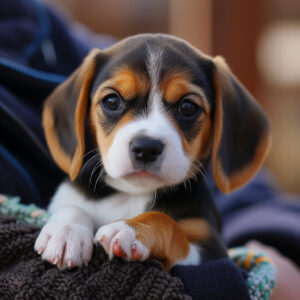Physical Address
304 North Cardinal St.
Dorchester Center, MA 02124

The Purebred Pocket Beagle is a small breed of dog that has a rich history dating back several centuries. The breed originated in England and was initially bred for hunting purposes. The name “Pocket Beagle” comes from the fact that these dogs were small enough to fit in a hunter’s pocket, making them easy to carry around during hunts.
The Purebred Pocket Beagle gained popularity in the 16th century when Queen Elizabeth I of England owned several of these dogs. She was known for her love of hunting and often took her Pocket Beagles with her on her hunting expeditions. This royal association helped to increase the breed’s popularity and led to its spread throughout England.
Today, the Purebred Pocket Beagle is still a beloved breed, known for its friendly and affectionate nature. While they are no longer used for hunting, they make excellent family pets and are cherished by dog lovers around the world.
The Purebred Pocket Beagle is a small dog with a compact and muscular build. They typically weigh between 10-15 pounds and stand at a height of around 10-12 inches at the shoulder. Despite their small size, they are sturdy and well-proportioned.
The breed has a short, dense coat that requires minimal grooming. They come in a variety of colors including tricolor (black, white, and tan), lemon and white, red and white, and orange and white. Some Pocket Beagles may also have ticking or freckles on their coats.
One of the unique physical features of the Purebred Pocket Beagle is their large, expressive eyes. They have a sweet and soulful expression that is hard to resist. Their ears are long and droopy, adding to their adorable appearance.

The Purebred Pocket Beagle is known for its friendly and outgoing personality. They are social dogs that love to be around people and are great with children. They are also generally good with other pets, although early socialization is important to ensure they get along well with other animals.
These dogs are intelligent and eager to please, which makes them relatively easy to train. However, they can be stubborn at times, so consistent and patient training methods are recommended. Positive reinforcement techniques, such as rewards and praise, work best with this breed.
Pocket Beagles have a playful and energetic nature. They enjoy being active and require regular exercise to keep them happy and healthy. They love to play games and participate in activities that engage their minds.
Like all dog breeds, the Purebred Pocket Beagle is prone to certain health issues. Some of the common health concerns for this breed include hip dysplasia, patellar luxation, epilepsy, and obesity. Regular veterinary check-ups and a healthy lifestyle can help prevent or manage these conditions.
On average, the Purebred Pocket Beagle has a lifespan of 12-15 years. However, with proper care and a balanced diet, some individuals have been known to live even longer.
To maintain good health in your Pocket Beagle, it is important to provide them with regular exercise, a nutritious diet, and regular grooming. Regular exercise helps to keep their weight in check and prevents obesity-related health issues. A balanced diet that meets their nutritional needs is essential for their overall well-being.
The Purebred Pocket Beagle is an intelligent breed that responds well to training. However, they can be stubborn at times, so it is important to use positive reinforcement techniques and be patient and consistent with their training.
Early socialization is also crucial for this breed. Exposing them to different people, animals, and environments from a young age helps them develop into well-rounded and confident dogs.
In terms of exercise, the Purebred Pocket Beagle requires regular physical activity to keep them happy and healthy. They have a lot of energy and enjoy activities such as walks, playtime in the yard, and interactive games. Mental stimulation is also important for this breed, so providing them with puzzle toys or engaging in training sessions that challenge their minds can help prevent boredom.

The Purebred Pocket Beagle has a short coat that requires minimal grooming. They are moderate shedders and only need to be brushed once or twice a week to remove loose hair and keep their coat looking healthy.
Bathing should be done as needed, typically every 4-6 weeks. It is important to use a dog-specific shampoo that is gentle on their skin and coat. Regular nail trimming is also necessary to prevent overgrowth and discomfort.
Cleaning their ears regularly is important to prevent ear infections. Use a dog-specific ear cleaning solution and gently wipe the inside of their ears with a cotton ball or soft cloth.
The Purebred Pocket Beagle has specific dietary needs to ensure they maintain a healthy weight and overall well-being. It is important to feed them a high-quality dog food that is appropriate for their age, size, and activity level.
Feeding should be done twice a day, with portion sizes based on their weight and activity level. It is important not to overfeed them as they are prone to obesity, which can lead to various health issues.
Treats can be given in moderation as rewards during training or as occasional snacks. However, it is important to choose healthy treats that are low in calories and do not contribute to weight gain.

The Purebred Pocket Beagle is a social breed that thrives on human companionship. They enjoy being part of the family and should not be left alone for long periods of time. They are well-suited to both apartments and houses, as long as they receive enough exercise and mental stimulation.
Socialization is important for this breed to ensure they are comfortable in various situations and get along well with other animals and people. Exposing them to different environments, sounds, and experiences from a young age helps them develop into well-adjusted adults.
When choosing a Purebred Pocket Beagle, it is important to find a reputable breeder who prioritizes the health and well-being of their dogs. Here are some tips for finding a reputable breeder:
1. Research breeders in your area and read reviews or ask for recommendations from trusted sources.
2. Visit the breeder’s facility or home to see how the dogs are kept and cared for.
3. Ask the breeder about health testing and any genetic health issues that may be present in their breeding lines.
4. Ask to meet the puppy’s parents to assess their temperament and overall health.
5. Ensure that the breeder provides proper documentation, including health records and registration papers.
It is important to avoid puppy mills or backyard breeders, as they often prioritize profit over the health and well-being of their dogs.
1. Are Purebred Pocket Beagles good with children?
Yes, Purebred Pocket Beagles are generally good with children. They are friendly and affectionate dogs that enjoy being part of the family.
2. Do Purebred Pocket Beagles get along with other pets?
Yes, with proper socialization, Purebred Pocket Beagles can get along well with other pets. Early exposure to different animals helps them develop positive relationships.
3. How much exercise do Purebred Pocket Beagles need?
Purebred Pocket Beagles require regular exercise to keep them happy and healthy. They should have at least 30 minutes to an hour of physical activity each day.
4. How long do Purebred Pocket Beagles live?
On average, Purebred Pocket Beagles have a lifespan of 12-15 years. However, with proper care and a healthy lifestyle, some individuals have been known to live even longer.
5. Are Purebred Pocket Beagles easy to train?
Purebred Pocket Beagles are intelligent and eager to please, which makes them relatively easy to train. However, they can be stubborn at times, so consistent and patient training methods are recommended.
In conclusion, the Purebred Pocket Beagle is a small and friendly breed that makes an excellent family pet. They have a rich history and are known for their playful and affectionate nature. With proper care, training, and socialization, they can thrive in various living arrangements and bring joy to their owners for many years.
If you’re considering getting a purebred pocket beagle, it’s important to be prepared for their unique needs and behaviors. One article that can provide valuable insights is “Tips for Taking Care of Your Beagle Puppy” from BeaglesPuppies.com. This article offers practical advice on everything from training stubborn beagles to understanding their shedding patterns. Whether you’re wondering when beagle puppies are fully grown or why your beagle puppy is shaking, this article covers it all. Click here to read the full article and ensure you’re ready to provide the best care for your new furry friend.